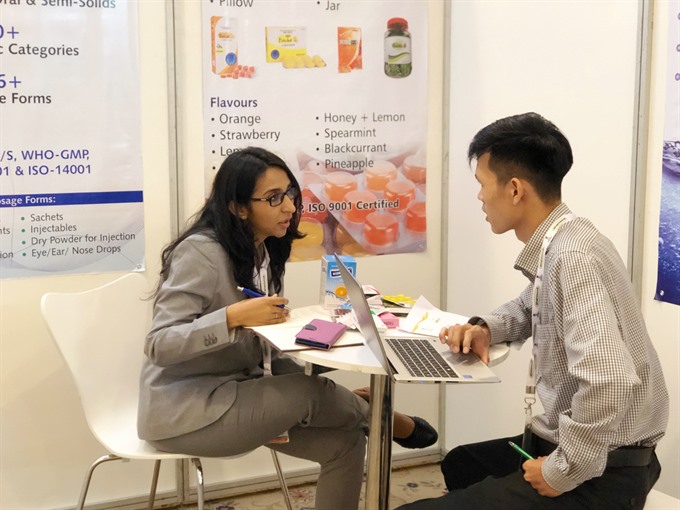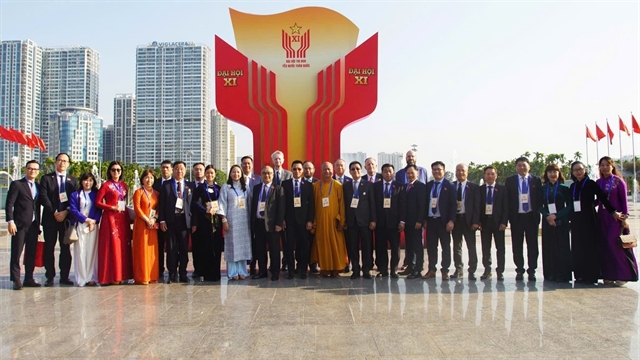 Economy
Economy

Significant potential for growth in trade in pharmaceutical and healthcare products exists between India and Việt Nam, experts at the Indian Pharmaceutical Exhibition and B2B Interaction said yesterday (Jan 21) in HCM City.
 |
| Representatives of Indian and Vietnamese firms in the pharmaceutical industry exchange information at the Indian Pharmaceutical Exhibition and B2B Interaction held at HCM City’s Rex Hotel on Monday and Tuesday (Jan 21-22). — VNS Photo Xuân Hương |
HCM CITY — Significant potential for growth in trade in pharmaceutical and healthcare products exists between India and Việt Nam, experts at the Indian Pharmaceutical Exhibition and B2B Interaction said on Monday in HCM City.
Speaking at the opening ceremony, Võ Tân Thành, deputy chairman of the Việt Nam Chamber of Commerce and Industry (VCCI), said that Việt Nam’s pharmaceutical industry in recent years had seen a two-digit growth rate and that growth momentum would continue until 2022.
“Although the domestic pharmaceutical industry has made strong progress, it only meets 52.5 per cent of domestic pharmaceutical demand,” he said.
The country has about 180 domestic and foreign pharmaceutical manufacturing firms, with about 194 factories of 158 enterprises meeting GMP-WHO standards.
Domestic production consists of mostly generic drugs directly produced for domestic consumption and outsourcing for foreign enterprises.
“On average, each year, about 60,000 tonnes of pharmaceutical materials are consumed, of which 80-90 per cent are imported mainly from China and India,” he said.
The country’s pharmaceutical import turnover reached US$2.8 billion in 2017, up 10 per cent from 2016, and hit $3 billion last year, he said.
“Việt Nam is currently an important trading partner of India in this area, as Việt Nam accounts for a fifth of India’s pharmaceutical products exports.
“In addition to finished products, India also provides raw pharmaceutical materials, and generic medicine materials for the Vietnamese market. The medicines and raw materials imported from India are reasonably priced and meet the diverse needs of Vietnamese, especially those living in remote areas.”
K Srikar Reddy, the Indian consul general in the city, said that India now ranks third globally in terms of volume of production of pharmaceutical products and 14th worldwide in terms of value.
It accounts for around 10 per cent of the world’s production by volume and 1.5 per cent by value.
“India is the only country in the world that has the highest number of USFDA-approved plants for generic drug manufacturing outside the US. Some of the leading Indian pharma companies derive about 50 per cent of their turnover from exporting generic medicines to developed markets like the US and Europe,” Reddy said.
The Indian pharmaceutical industry has emerged as a world-class, cost-effective generic drug manufacturer for drugs used for life-threatening diseases for AIDS, tuberculosis, cancer and others, he said.
“The demand for quality healthcare is growing every year with rising incomes in Việt Nam. Moreover, the changing disease pattern with the continuous rise of the elderly population over the age of 60 years will also contribute to greater healthcare spending in Việt Nam,” he said. “There will be a higher demand for affordable medicines as well as sophisticated medical devices and equipment in Việt Nam.”
In addition, Indian herbal and traditional medicine products in Việt Nam have great potential because the number of wellness centres, catering to an increase in the number of foreign tourists, is growing in the country.
Medical devices, surgical equipment and pharmaceutical machinery have emerged as the “sunrise sector” of India, which is currently valued at $5 billion and is expected to reach $11 billion by 2022.
Indian medical devices are now exported to over 150 countries, including Việt Nam, Reddy said.
Organised by VCCI and the Pharmaceuticals Export Promotion Council of India, the event offers opportunities for businesses of the two countries to exchange ideas, network and take advantage of opportunities for co-operation.
At the two-day event, 30 Indian pharmaceutical companies are showcasing many products. Among them are active pharmaceutical ingredients, bulk drugs and exipients, intermediates, finished formulations, liquid orals, oral dosages, tablets and capsules, injectables, medical devices, surgical and wound care products, pellets, nutraceuticals and food supplements, cosmeceuticals and skin care, vitamins and probiotics, herbal products and veterinary formulations. — VNS




